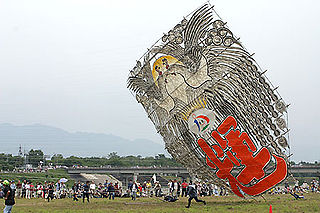
A kite is a tethered heavier-than-air or lighter-than-air craft with wing surfaces that react against the air to create lift and drag forces. A kite consists of wings, tethers and anchors. Kites often have a bridle and tail to guide the face of the kite so the wind can lift it. Some kite designs do not need a bridle; box kites can have a single attachment point. A kite may have fixed or moving anchors that can balance the kite. The name is derived from the kite, the hovering bird of prey.

An autogyro, or gyroplane, is a class of rotorcraft that uses an unpowered rotor in free autorotation to develop lift. While similar to a helicopter rotor in appearance, the autogyro's unpowered rotor disc must have air flowing upward across it to make it rotate.
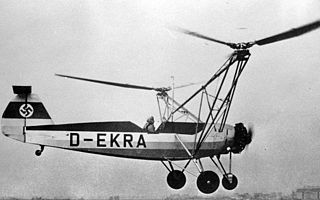
The Focke-Wulf Fw 61 is often considered the first practical, functional helicopter, first flown in 1936. It was also known as the Fa 61, as Focke began a new company—Focke-Achgelis—in 1937.

Focke-Achgelis & Co. G.m.b.H. was a German helicopter company founded in 1937 by Henrich Focke and Gerd Achgelis.

Henrich Focke was a German aviation pioneer from Bremen and also a co-founder of the Focke-Wulf company. He is best known as the inventor of the Fw 61, the first successful German helicopter.

The DFS 230 was a German transport glider operated by the Luftwaffe in World War II. It was developed in 1933 by the Deutsche Forschungsanstalt für Segelflug with Hans Jacobs as the head designer. The glider was the German inspiration for the British Hotspur glider and was intended for airborne assault operations.
German submarine U-852 was a Type IXD2 U-boat built for Nazi Germany's Kriegsmarine during World War II. The submarine, which was a special long-range version of the Type IX, had four bow and two stern torpedo tubes and a Focke-Achgelis Fa 330 Bachstelze cable-towed lookout gyroglider. It was laid down in Bremen and completed in June 1943. She was commanded by Kapitänleutnant Heinz-Wilhelm Eck, who led her through her sea trials and onto her first war patrol on 18 January 1944.

A submarine aircraft carrier is a submarine equipped with aircraft for observation or attack missions. These submarines saw their most extensive use during World War II, although their operational significance remained rather small. The most famous of them were the Japanese I-400-class submarines and the French submarine Surcouf, although small numbers of similar craft were built for other nations' navies as well.

The Focke-Achgelis Fa 223 Drache was a helicopter developed by Germany during World War II. A single 750-kilowatt (1,010 hp) Bramo 323 radial engine powered two three-bladed 11.9-metre (39 ft) rotors mounted on twin booms on either side of the 12.2-metre-long (40 ft) cylindrical fuselage. Although the Fa 223 is noted for being the first helicopter to attain production status, production of the helicopter was hampered by Allied bombing of the factory, and only 20 were built.

Wunderwaffe is a German word meaning "wonder-weapon" and was a term assigned during World War II by Nazi Germany's propaganda ministry to some revolutionary "superweapons". Most of these weapons however remained prototypes, which either never reached the combat theater, or if they did, were too late or in too insignificant numbers to have a military effect. The V-weapons, which were developed earlier and saw considerable deployment, especially against London and Antwerp, trace back to the same pool of highly inventive armament concepts. In the German language, the term Wunderwaffe generally refers to a universal solution which solves all problems related to a particular issue, mostly used ironically for its illusionary nature.

The Flettner Fl 282 Kolibri ("Hummingbird") is a single-seat intermeshing rotor helicopter, or synchropter, produced by Anton Flettner of Germany. According to Yves Le Bec, the Flettner Fl 282 was the world's first series production helicopter.

A rotor kite or gyrokite is an unpowered, rotary-wing aircraft. Like an autogyro or helicopter, it relies on lift created by one or more sets of rotors in order to fly. Unlike a helicopter, gyrokites and rotor kites do not have an engine powering their rotors, but while an autogyro has an engine providing forward thrust that keeps the rotor turning, a rotor kite has no engine at all, and relies on either being carried aloft and dropped from another aircraft, or by being towed into the air behind a car or boat or by use of ambient winds for the kiting. As of 2009, no country in the world requires a license to pilot such a craft.
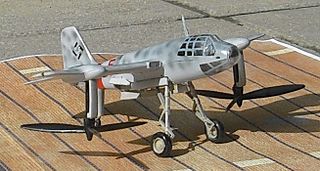
The Focke-Achgelis Fa 269 was a tiltrotor VTOL aircraft project designed by Henrich Focke.

The Focke-Achgelis Fa 225 was an experimental single-seat rotary wing glider built in Nazi Germany by Focke-Achgelis in 1942. Only a single example was constructed.

During World War II, aviation firmly established itself as a critical component of modern warfare from the Battle of Britain in the early stages to the great aircraft carrier battles between American and Japanese Pacific fleets and the final delivery of nuclear weapons. The major combatants. Germany and Japan on the one side and Britain, the United States and the USSR on the other manufactured huge air forces which engaged in pitched battles both with each other and with the opposing ground forces. Bombing established itself as a major strategic force, and this was also the first war in which the aircraft carrier played a significant role.
The Airborne Forces Experimental Establishment (AFEE) was a branch of the British Air Ministry, that researched and developed non-traditional airborne applications, such as gliders, rotary wing aircraft, and dropping of personnel and equipment by parachute, in the period 1942–1950.
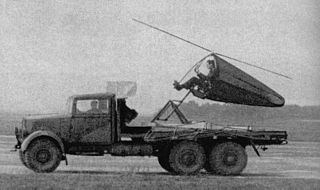
The Hafner H.8 Rotachute was a British 1940s experimental one-man rotor kite designed by Raoul Hafner.
Lashenden Air Warfare Museum is an aviation museum at Lashenden (Headcorn) Airfield in Kent in southeast England.
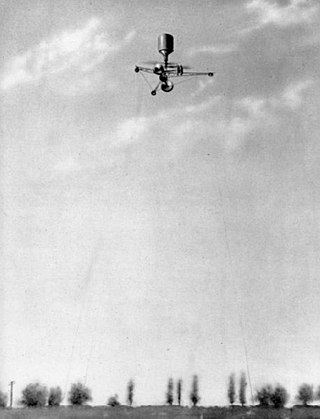
Petróczy, Kármán and Žurovec were Hungarian and Czech engineers who worked on helicopter development immediately before and during World War I in Budapest. Between them they produced two experimental prototypes, the PKZ-1 and PKZ-2, intended to replace the dangerous hydrogen-filled observation balloons then in use. As such, these craft were tethered on long cables and were not intended to fly freely. After the war other engineers, notably Oszkár von Asboth, further developed the design.


















